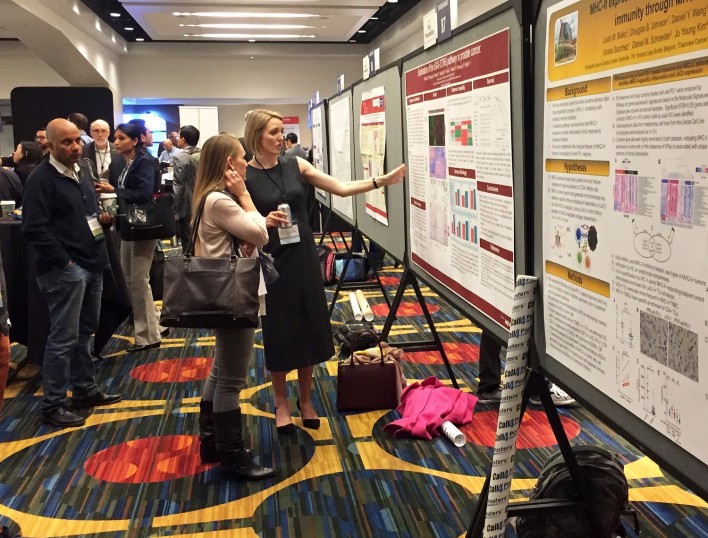The 2018 Clinical Immuno-Oncology Symposium, held this week in San Francisco, offered a good overview of the state of immunotherapy for many different types of cancer, as well as some new findings on the latest approaches.
I enjoy small specialty meetings like this, the Gastrointestinal Cancers Symposium last week and the upcoming Genitourinary Cancers Symposium as they offer a chance to delve into specific topics and get to know the researchers outside the overwhelm of the huge American Society of Clinical Oncology (ASCO) annual conference in June.

Poster session at ImmunoOnc18Liz Highleyman
ImmunoOnc18, cosponsored by ASCO and the Society for Immunotherapy of Cancer (SITC), focuses on treatments that help the immune system recognize and fight cancer cells, which can often hide from or turn off natural responses against them.
Jeffrey Bluestone, PhD, CEO of the Parker Institute for Cancer Immunotherapy, gave a nice overview of the history of the field of immuno-oncology, from the 1970s, when radiation therapists were largely “in charge” of cancer treatment, through an “inflection point” in the late 1980s and 1990s when we began to understand how T cells respond—or don’t—to cancer, including the discovery of immune checkpoints like PD-1 and CTL4.

Jeffrey Bluestone at ImmunoOnc18Liz Highleyman
It took years for therapies based on these discoveries to make it to the clinic, but by the mid-2000s they were showing clear benefits—for some patients with some types of cancer. More recently, modified cells have once again changed way we think about immunotherapy, according to Bluestone. The first child treated with CAR-T therapy for leukemia, Emily Whitehead, almost died from the treatment, but she has now been cancer-free for more than five years. “Her experience really changed the world,” Bluestone said.
CAR-T therapy has been big news in the cancer world, with last year’s approval of Novartis’s Kymriah (tisagenlecleucel) and Kite/Gilead’s Yescarta (axicabtagene ciloleucel).
At the symposium researchers presented data on Juno’s JCAR017 or lisocabtagene maraleucel, which looks promising for non-Hodgkin lymphoma and may be safe enough for outpatient administration. Unleashing supercharged T cells can lead to an overactive immune response known as cytokine release syndrome—or “cytokine storm”—but experts are getting better at managing it successfully.
The first CAR-Ts target CD19, a protein on B cells that grow out of control in leukemia and lymphoma. But other targets are possible. Kristen Fousek, MS, of Baylor College of Medicine in Houston presented early findings from lab and mouse studies of an experimental CAR-T that works against three proteins (CD19, CD20 and CD22), meaning it could still work if a cancer manages to evade one of them.
Despite enormous progress, cancer is still not fully curable, of course. Some people, and some types of cancer, don’t respond initially to immunotherapies, while others respond at first but the drugs stop working as the cancer develops resistance. Mechanisms of resistance, and how to overcome it, is a major theme in immunotherapy research. Most experts seem to think that cancer—like HIV—will require a combination approach.
Because they work by taking the brakes off T cells, checkpoint inhibitors like Keytruda (pembrolizumab) and Opdivo (nivolumab) work best against so-called “hot” tumors with many mutations that attract T cells. This type of treatment is approved for melanoma, bladder, kidney, lung and head and neck cancers, all of which had sessions devoted to them at the conference. Today’s CAR-T therapies are effective against blood cancers such as leukemia and lymphoma.

Sumanta Pal and James Gulley at ImmunoOnc18Liz Highleyman
But existing immune therapies generally don’t work well against “cold” cancers like breast, ovarian and prostate cancers, though much research is underway in these areas, as described in a presentation by James Gulley, MD, PhD, of the National Cancer Institute.
Keytruda was the first drug approved for tumors with deficiencies in their DNA mismatch repair (dMMR) system, leading to so-called microsatellite instability, regardless of where it occur in the body. Immunotherapy is at the forefront of this so-called tumor agnostic approach, the subject of an informative session featuring Colin Pritchard, MD, PhD, of the University of Washington and Dung Le, MD, of Johns Hopkins University.

Dung Le at ImmunoOnc18Liz HIghleyman
This approach has the potential to upend the way cancer research is usually now done, one body part at a time. “The field is very siloed,” said Le, asking who will enroll patients in tumor agnostic trials—and why not include children and adults together in the same studies?
This new way of looking at cancer could also be challenging for patient support and advocacy groups, which have traditionally been organized by cancer type. But some are going in this direction, including METUP, which started with advocacy for people with metastatic breast cancer but are aiming to include people with other late-stage cancers who are often excluded from clinical trials because their disease is considered too advance.
Perhaps not coincidentally, I didn’t see any advocacy or support groups in the exhibit hall at ImmunoOnc18.

Jon Mendelson and David Yoskowitz of Ice-Cold Mouthpiece.com at ImmunoOnc18Liz Highleyman
I did, however, learn about a new device to manage treatment side effects. The Ice-Cold Mouth Piece works by chilling the mouth during chemotherapy to help prevent oral sores. The new device works on the same principle as the scalp cooling cap to prevent hair loss and frozen gloves and socks to prevent neuropathy caused by chemo.








Comments
Comments